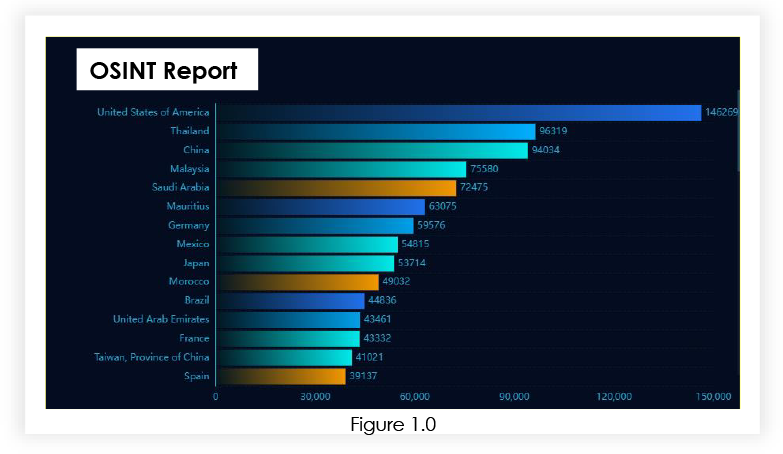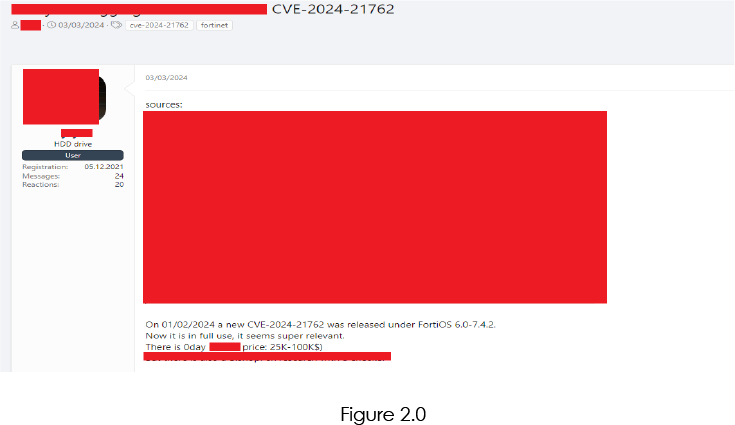



CVE-2024-21762 exposes a critical vulnerability in Fortinet’s FortiOS/FortiProxy, potentially allowing threat actors to execute arbitrary code remotely. The vulnerability impacts a vast array of Fortinet’s products, potentially affecting over 1,559,605 devices globally. Mitigating this risk demands immediate action from organizations, including applying patches provided by Fortinet and implementing additional security measures to fortify network defenses against potential exploits.
CYFIRMA Research has conducted an analysis on the vulnerability, known as CVE-2024-21762, which has sent shockwaves through cybersecurity circles, posing a critical threat to organizations worldwide. This vulnerability specifically targets Fortinet’s FortiOS/FortiProxy, a crucial operating system that powers Fortinet’s FortiGate firewalls, vital for network security. Exploitation of this flaw allows for remote code execution (RCE), granting unauthorized access of sensitive networks to malicious actors. This underscores the urgent necessity for robust cybersecurity measures and proactive threat intelligence to effectively safeguard against evolving cyber threats.
Key Takeaways:
Acknowledgements:
CYFIRMA Research acknowledges the collaborative efforts of security researchers and the cybersecurity community in identifying and addressing the CVE-2024-21762 vulnerability.
Vulnerability Type: Unauthenticated Remote Code Execution (RCE)
CVE ID: CVE-2024-21762
CVSS Severity Score: 9.6 (Critical)
Application: Fortinet’s FortiOS/FortiProxy
Impact: Allows unauthenticated attackers to execute arbitrary code by exploiting a critical remote code execution vulnerability.
Severity: Critical
Affected Versions: Multiple versions of Fortinet’s FortiOS/FortiProxy are impacted. Check here
Patch Available: Yes
Mitigation: Organizations are strongly advised to apply the latest security updates and patches promptly.
CVE-2024-21762 is an out-of-bounds write vulnerability discovered in Fortinet’s FortiOS/FortiProxy. This flaw resides in the SSL VPN functionality, allowing remote attackers to execute arbitrary code without authentication. By sending crafted HTTP requests to the vulnerable device, attackers can trigger a buffer overflow condition, potentially leading to remote code execution. This vulnerability affects multiple versions of FortiOS/FortiProxy, exposing a wide range of Fortinet products to exploitation.
The exploitation of CVE-2024-21762 could result in severe consequences for affected organizations. Unauthorized access to Fortinet’s FortiOS/FortiProxy enables threat actors to compromise network security, exfiltrate sensitive data, or launch further attacks within the network infrastructure. This vulnerability poses a significant risk to the confidentiality, integrity, and availability of critical assets and infrastructure.
Multiple versions of Fortinet’s FortiOS/FortiProxy are affected by CVE-2024-21762. Detailed information on specific affected versions is available through Fortinet’s security advisories. Check here.
Is there already an exploit tool to attack this vulnerability?
As of the latest available information, there are known public exploit tools for CVE-2024-21762 targeting Fortinet’s FortiOS/FortiProxy.
Has this vulnerability already been used in an attack?
Regarding exploitation, while CVE-2024-21762 poses a critical risk, there is no specific information confirming active exploitation of this vulnerability now. However, organizations should remain vigilant and prioritize applying patches promptly.
Are hackers discussing this vulnerability in the Deep/Dark Web?
CYFIRMA’s observations have identified current discussions or potential exploitation of CVE-2024-21762 in the Deep/Dark Web.
What is the attack complexity level?
The attack complexity level for CVE-2024-21762 in Fortinet’s FortiOS/FortiProxy is assessed as LOW. A public exploit tool is available, organizations should prioritize mitigation efforts and implement robust security measures to protect against potential exploitation.
Historical Trends and Known Exploits:
There are known exploits or historical trends for Fortinet. However, organizations must recognize the significant risks associated with this vulnerability and apply updates, and enhance security measures to mitigate potential threats. Regular updates and initiative-taking security measures are crucial to defend against evolving cyber threats.
Our analysis found that more than 1,559,605 + Fortinet’s FortiOS/FortiProxy are public, which can be vulnerable to CVE-2024-21762.

This exploitation hinges on manipulating crafted HTTP requests using chunked transfer encoding, presenting an avenue for attackers to breach system security.
Chunked Transfer Encoding, a fundamental feature of HTTP/1.1, helps the transmission of HTTP payloads with indeterminate sizes. By segmenting the payload into sequential chunks, each marked by a hex-encoded length value, followed by a carriage return and line feed (CRLF), data of variable lengths can be efficiently transmitted.
The core of CVE-2024-21762 lies in manipulating the chunk size field within HTTP requests, to trigger an out-of-bounds write condition in the SSL VPN component. By inflating the chunk size values beyond expected limits, attackers can induce unexpected memory accesses, potentially leading to the execution of arbitrary code within the compromised system’s context.
The proof of concept’s efficacy stems from its ability to induce observable behavioural changes in the target system. Intentionally withholding sufficient data in the HTTP request causes the system to block during the attempted processing of the incomplete payload. This distinct behaviour serves as a clear indicator of successful exploitation.
Organizations are strongly recommended to apply patches provided by Fortinet to remediate CVE-2024-21762. Additionally, implementing network segmentation, access controls, and intrusion detection systems can help mitigate the risk of exploitation. Regular security audits and updates are essential to maintaining a robust security posture against emerging threats like CVE-2024-21762.
Target Geography:
Organizations worldwide relying on Fortinet’s FortiOS/FortiProxy are affected by CVE-2024-21762. The geographical impact spans regions such as North America, Central Europe, Asia, and beyond, where Fortinet’s products are extensively deployed. Regardless of location, organizations utilizing FortiOS/FortiProxy, particularly the affected versions, are susceptible to potential exploitation of this critical vulnerability.
Target Industry:
The vulnerability in Fortinet’s FortiOS/FortiProxy poses a threat across various industries, including healthcare, finance, government, telecommunications, and others relying on Fortinet’s products for network security. Threat actors may target industries based on the perceived value of the data or services protected by FortiOS/FortiProxy. Industries handling sensitive information or those heavily dependent on Fortinet’s solutions may face heightened risks.
Target Technology:
CVE-2024-21762 specifically impacts Fortinet’s FortiOS/FortiProxy, a crucial component of network security infrastructure. Successful exploitation of this vulnerability may not only compromise FortiOS/FortiProxy instances but also jeopardize interconnected systems, applications, and devices within the organization’s network. This highlights the potential ripple effect on an organization’s technological ecosystem, necessitating comprehensive mitigation strategies.
Understanding the global impact, cross-industry ramifications, and technological implications of CVE-2024-21762 is essential for organizations to assess their exposure accurately. Swift action through patching, proactive security measures, and vigilant monitoring is imperative to mitigate the risks associated with this critical vulnerability.
Currently, there are ongoing discussions of the vulnerability, however, there is no mention or sign of the sale of any exploits on the forum.

In conclusion, CVE-2024-21762 poses a critical threat to organizations worldwide. Immediate action is imperative for those utilizing Fortinet’s FortiOS/FortiProxy. Swift patching and heightened security measures are essential to mitigate the risk of unauthenticated remote code execution. Collaboration, proactive monitoring, and prompt response, guided by CYFIRMA’s insights, are pivotal in defending against potential exploitation and safeguarding critical assets.